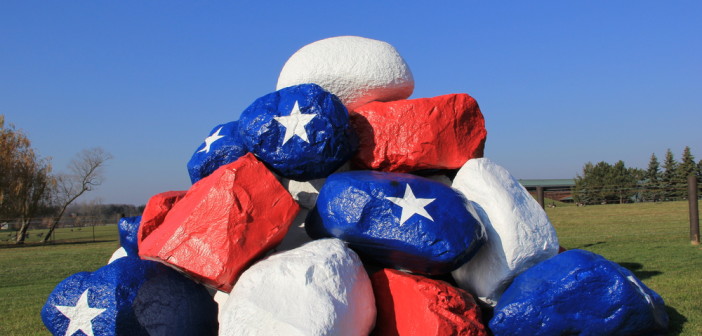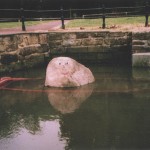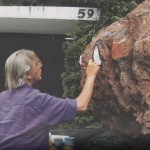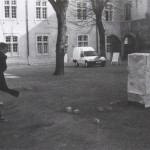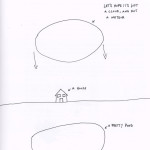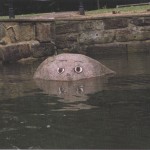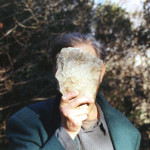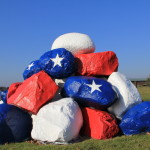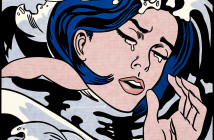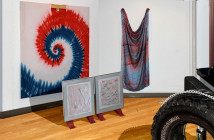Most of the time you are not careful with the everyday things. Pardon my saying so, but it is a bit like lack of integrity to ignore the integrity of these things.
—Jimmie Durham
Among the assurances we are afforded by contemporary culture and its insistent overproduction, the steady stream of commentaries on philosophical themes variously dubbed "object-oriented" or "thing-powered," guarantees an abundant supply of allegedly post-anthropocentric literature for the contemporary reader. Notwithstanding the often puzzling absence of historical reflexivity—as if no one before the mid-2000s had noticed the agency of non-human actors—what is most troubling about this flourish of other-than-human theoretical investigation is its coincidence with the irrefutable evidence of anthropogenic climate change.
Originally in The Second Particle Wave Theory, 69.
It is as if, at the moment when human actors face the consequences of their human activities most decisively, theorists recoil from this reality, turning their attention instead toward advancing rich descriptions of the unlikely details of trivial everyday objects, refuse, or other menial ephemera.1 In a moment of environmental collapse, mass extinction, and climate chaos, it seems that theory is content to just trend along on liberal pseudo-politics, quasi-activism, and twee curiosity. But, what is even more than troubling about this trendy deluge, what should, in fact, be a startling alarm for all of us, is how decidedly and consistently thing-theorists abjure the role of cultural struggle while lauding the theoretical agency of objects.
In what follows, I recount the parable of Jimmie Durham’s residency in Lascaux. This parable shapes our inquiry into the role of human agency, human art, and the philosophical paralysis conjured forth by the ambition for a non-anthropocentric thought within a world of irreversible anthropogenic reformation. Jimmie Durham’s lesson, if it is in fact one we can share, is that the value of our attention to things or objects, to their powers or orientations, and to their transient and shifting meaning, is an especially human endeavor indelibly entangled within the history of cultural politics and the integrity of cultural adaptation and resilience. But, before we begin the parable of Jimmie Durham, we will first consider, with Michel Serres, why tigers piss at the edge of their caves.
The Aesthetics of Occupancy
The artist: the first person to set out a boundary stone, or to make a mark.
—Deleuze & Guattari
In a recent and rather hurried little book, French philosopher of science Michel Serres questions the relationship between appropriation and filth. For Serres, "The science of animal behavior, ethology, describes at length those nests, holes, wallows, sheds, ecological niches . . . in short, how males define and defend their habitats with their filth. These places are often secret, hidden, dark, buried, lost, places where the living eat, sleep, hibernate, copulate, give birth, and are born, in short survive; do they own or rent these places?"2 The answer is delivered by way of his extension of the question of filth to that of pollution, but also through his insistence on their common bodily origins. In his words, "appropriation takes place through dirt" because "bodily discharges, that is, urine, manure, or corpses as well as sperm, were used to appropriate places."3 Following his consideration of a series of exemplary appropriating emissions, Serres arrives at the following summary:
The increasing volume of trash or excretions—urine, sperm, blood, corpses . . . that still bodily or physiological excretions, marks the extension of appropriated space—nest, farm, city, country—and also the increase in the number of subjects of appropriation—individual, family, nation. For the rhythm of this increase to stop and then suddenly to change into a vertical spurt engulfing the planet and humanity, it had to go from cemeteries or bodily excretions, subjective or human, to more objective trash: sewage farms, public dumps . . . in big cities, industrial waste that is less biodegradable, or world-objects in the world. We have now arrived.4
We have arrived in the epoch of the anthropocene, where the appropriation of the world through human pollution moves from a subjective and organic marking of contested territory to an objective series of claims that operate preventatively: The human is the occupier of the earth most especially by way of destroying it so thoroughly that no other species can survive in proximity to our (i.e., human) waste.5 Thus, if the first act of appropriation through piss or shit is a territorial sign made though bodily expulsions, we must ask, with Serres, "How does the physiological change into brute matter, and vital excrement into chemical waste? This is how: earlier, I called externalization the process by which our manufactured objects emerge from our organisms or their various functions. Here are examples: clothing derives from hair and skin and replaces them; the hammer struggles out of the forearm and the fist; the wheel imitates joints, ankles, and hips. Thus our appliances rig out the organs of our bodies."6 Serres calls this appliance-driven out-rigging of the body Exo-Darwinism to characterize it as an evolving, processual dynamic that occurs alongside the biological evolution of species, but according to its own rhythm. Following the trajectory of the philosopher Manuel DeLanda, we could also call this process mineralization, as a way of naming the process wherein organic bodies enlist the capacities of inorganic substances to advance their development—from the endo-skeletal morphogenesis of bones, claws and teeth, to the exo-skeletal development of tall buildings with HVAC systems. But, between the upright infra-rigged proto-Homo Sapien and the Exo-Darwinian office tower there is a threshold of differential occupation, a phase of "belonging" to the earth as a kind of occupying through emissions that primes us for the parable of Jimmie Durham. We call this threshold meso-space the cave.
Aesthetics & Apprenticeship, Part I
. . . what would it be to forget, in the silence and isolation of the cave, one’s solitude?
Can there be, today, a community of the cave?
—Stuart Kendall
The cave begins and ends the history of Western metaphysics by admitting a line of continuity from the Plato’s academy to Luce Irigary’s speculum, but it is among the ancients’ estimations of the visual economy of knowledge that we’ll now pause.7 Plato’s allegory of the cave is perhaps the most well-known reference in ancient philosophy, and certainly one of the most considered images of thought in the Western tradition, yet it bears repeating, or at least paraphrasing, for reasons I will explain momentarily. In the beginning of Book VII of The Republic, Plato’s Socrates asks his interlocutor Glaucon to imagine a cave where men have been kept for their whole lives in chains, so that the images they see on the wall of the cave—shadows cast by passersby and their various possessions—are readily mistaken for reality as such. Socrates leads Glaucon through the allegory by asking him to consider a man freed from such a condition, and whether it would be possible for such a man, if he was shown the objects that cast the shadows he had previously mistaken for reality, to understand what he was viewing. Not only does this dialectical maneuver allow Socrates to emphasize the heuristic role that this upheaval of knowledge would play in his "philosophical turn," it also introduces us to the force of thought itself. Socrates explains, with Glaucon’s approval, that the man freed from the prison of the cave would refuse to look at the objects that cast the shadows, as well as the sun which itself made them visible, because of the pain this would cause his eyes. The Socratic elision of distinction between physical pain and intellectual difficulty thus completes the allegorical ascent, from imprisoned cave dweller to enlightened being accessing a deeper, more comprehensive, universal reality. Plato’s allegory of penumbral illusion and begrudging emancipation is thus a story of coming to belong, or of coming into a proper relation with the world and its politics through knowledge. If knowing can be seen as an exclusion from the community of the cave, which in part it is, the same shift in knowing also enacts an inclusion in another, more eternal relation of unchanging, universal knowledge.
There are thus two reasons to repeat the parable of the cave: first, the allegory performs a slippage that allows knowing to stand in for belonging, thereby positing true belonging as an achievement, goal, or telos that is positioned on the horizon of possibility in a "post-cave" community. The second reason for this repetition is that Plato’s cave is strangely lacking in any trace of the human, despite the imprisoned figures within it. Where are the paintings? Are these prisoners not themselves makers of images and representations, and, if not, can they still be considered a sufficient allegorical stand-in for the human? The movement from Plato’s allegorical cave to the cave of Lascaux is therefore a move from a passive experience of the image, as a form received and poorly decoded, to an active production of the image as a mediating social relation to the outside.
The productive and social dimension of the prehistoric painting provoked the French archaeologist, anthropologist, and philosopher André Leroi-Gourhan to consider the complex relation between art and technique operative in Paleolithic cave paintings.8 Similarly, the cave at Lascaux provoked the French Medievalist and philosopher Georges Bataille to write his Prehistoric Painting: Lascaux or The Birth of Art, where he argues the paintings of Lascaux offer a dramatic visualization of the process of becoming-human—wherein the artist-protagonists of Bataille’s description begin to narrate, in painting, the distinction that is unfolding between them and their once-immanent milieu. For Bataille, art and religion function as ritual activities performed as a means to create an event of immanence that is lost in the emergence of the human as such.9 While there is no evidence in the current scholarship to suggest that this question of culture as a projective negotiation of immanence in Lascaux is what attracted Jimmie Durham to the site, it is important to say here that these connections cannot be ruled out in advance.
I want out of this century.
—Jimmie Durham
Admittedly, details of the passage from his role as a Cherokee activist, poet, and artist (until 1980 he was director of the International Indian Treaty Council and a member of the A.I.M. Central Committee) to his residency in prehistoric Lascaux merits more consideration than the brief space of this essay permits; suffice it to say for our purposes that this journey was one of formidable speculative intensity.10 It also fostered an erratic engagement with the technologies of "out-rigging" described by Michel Serres above. In his reflection on prehistoric apprenticeship, My Book, The East London Coelacanth, Sometimes Called, Troubled Waters: The Story of British Sea-Power, Begins with a Chapter Titled, Jimmie Durham describes how our lack of attention to everyday things results not, as some would have it, from an underestimation of the agency of things, but instead from the urgency of narratives that construct our feelings of social responsibility.11 He writes, "What I mean is, simply, that the pressures upon you by a very inclusive State Narrative mitigates against fondling of this page which, after all, you hold manually with your marvelously dexterous fingers and read the words printed hereon with your beautifully-constructed, delicate eyes; and remembering the myriad political histories involved—from growing tree to pulp factory."12 And, further, to the reader: "You say you cannot possibly take the time to ponder those histories and qualities of every single thing you might bump into, sit on, drink from, etc. during a typically busy day during which you have real social responsibilities."13 From this perspective, involuntary participation in the social milieu operates as an alibi for the avoidance of banal, ponderous thoughts about the everyday. But, Jimmie Durham asserts the value of expending this mental energy, curiously embarrassing for most of us because we want to be seen as focused, productive individuals, on the "contemplative investigation of everyday things." This contemplative turn is, insistently, not toward things, but, as Jimmie Durham explains through his description of metal-fatigue—"if metal is given continued stress at any given point the molecular structure goes rotten at the core, as it were"14—toward the unavoidable complicity between things and human actors.
While some might expect that, during his residency in Lascaux, it was Jimmie Durham who gained some imagined secret from prehistoric art, this visit is actually an exemplary case of what is known today as reverse plagiarism. It is the prehistoric cave artists who, in their engagement with Jimmie Durham, are provoked into realizing that culture is a form of integrity. Far from the enthusiasm for the same that characterizes fearful conservative cultural politics, the apprenticeship in Lascaux relieved the art of two decisive lessons regarding culture: first, cultural struggles are struggles for self-determination—for example, how prehistoric proto-humans came to articulate themselves against the various adversaries they faced, whether predatory, climactic, or combative; and, second, that self-determination is not at all a process of remaining the same, but is instead entirely caught up with the entangled complicities of material life, and as such it comprises a rhythm of transformation and change. This is not least because we (humans) are never entirely in control of the technologies through which we learn express ourselves and transform our environments, "So where is your so-called ‘personal autonomy’ then, Mr. or Ms. Bigshot?"15
Aesthetics & Apprenticeship, Part II
Why should molecules of metal lose the will to cohere in the first place?
Does that ever happen away from human society?
—Jimmie Durham
Of the many lessons imparted during the residency in Lascaux, Jimmie Durham’s explication of the relationship between culture and revolutionary struggle is perhaps the most consequential, especially because of his particular attention to the role of objects or artifacts of culture in such struggles. In essence, much of the residency was spent retelling the story of the arrogance of the Native American Support Committee (NASC), who, in the early 1970s, attempted to impart their allegedly revolutionary wisdom in one of two ways: by romanticizing Native American nations as "noble savages," or by infantilizing them as "primitives" in need of Marxist guidance. In either case, what was necessary to explain was that the cultures of solidarity that emerged around Native American political struggles tended to reiterate the reactionary values of a predatory settler nation.
Let us recount what Jimmie Durham explained. "Our societies, our culture, defines us, in a large part, and our way of experiencing the world is through our culture. Politics, economics, science and technology, language, etc., are all cultural phenomena, finally, of course, political phenomena. And I am saying that many progressive people in this country, particularly many whites and blacks, are not critically conscious of that process, and are a part of that mass society in one degree or another."16
Christine König Galerie, Vienna.
Because of this, he continued, "we have always defined our struggle not only as a struggle for land but also as a struggle to retain our cultural values. […] The struggle to maintain culture is in itself a revolutionary struggle. It is a dynamic and positive struggle, not a passive holding action. […] The traditions we mean are not the exterior manifestations that are easily identified as "Indian," not the "artifacts" and objects of our culture, but what we call our "vision"—the value system that makes our culture. In short, we mean our political system (but remember we have been taught a special vocabulary), not our well-made arrowheads."17 To help the prehistoric cave artists understand the stakes of these relations, especially the relations between forms and force, or artifacts and politics, Jimmie Durham explained the cultural dynamics of contact between the Cherokee Nation and the settlers. He explained it like this:
When the Cherokee Nation first came into contact with the settler regime we were impressed by iron tools. We became the blacksmiths and knife-makers of the South soon after. […] We didn’t (and don’t) stop to think whether or not iron-working was a valid "Cherokee" or "Indian" activity. Taking new ideas that are useful is a very Cherokee activity. It is a very Lakota, or Mohawk activity. We took glass beads, horses, wool blankets, wheat flour for fry-bread, etc., very early, and immediately made them identifiable "Indian" things. We are able to do that because of our cultural integrity and because our societies are dynamic and able to take on new ideas. […] Since the 1840s, and especially recently, it is obviously a very "Indian" thing to use the best and most modern rifles available to us. One of our valued traditions is to use the best possible weapons to fight our oppressor.18
Jimmie Durham explained the importance of thinking about cultural struggles not merely through the reductive evidence of objects and artifacts, but through the adaptive capacities that such objects allow and demand. It is not a question of any artifact belonging to its culture—as an object seen in Plato’s cave would belong, properly and knowingly, to its Platonic form when seen in the light of the sun—but of a culture advancing according to a rhythm that permits coincidence and complicity among various registers of artifacts, tools, and weapons. This is also why painting on rocks, as a form of expression that challenges—by doubting—the progressive stride of our technological appliances, is not properly a prehistoric aesthetic form; it is also a form used as a contemporary weapon in the work of Jimmie Durham.
Last Laughs
Extinguish all nostalgia for belonging.
—Nick Land
Jimmie Durham’s painting isn’t exactly figurative. It’s comedic, ruthlessly. His child-like smiley faces are painted with careful attention on the surface of boulders, which are then dropped by industrial cranes on the various appliances of out-rigged human activity, such as cars, airplanes, and boats. If our out-rigged hyper-mobility is an "Exo-Darwinian" technology, in the sense that we described it, following Serres, above, then Jimmie Durham is a hyper-scruple: His smiling boulder sculptures crush our most familiar technological appliances and vex our hope for belonging to these not-so-eternal objects. Who is the protagonist in this event of aesthetic dispossession? Is it the rock, absolved of its inorganic stasis by a comedic face of jest?
Is it the automobility of the contemporary user, crushed under the weight of geologic proportion? Or, could these comedic inversions undo our ability to think of the protagonist altogether? Before we respond to these questions, we should first insist that the technological out-rigging described by Serres above was the exo-skeletal development of instrumental means. Our concern, however, is with aesthetic expression that does not refer back to any prior utility or necessity. With this in mind, we return once more to the primal scene, this time with German director Werner Herzog, where we begin to feel the continuation of human endeavors start to splinter. Like many of Jimmie Durham’s sculptures, Herzog’s recent 3D film Cave of Forgotten Dreams (2010) provides an exemplary retaliation on any viewer in search of a human protagonist. Throughout the film, Herzog allows us to develop a certain intuitive connection with the prehistoric artists of the Chauvet-Pont-d'Arc Cave. Herzog assembles his documentary as a series of archaeological, anthropological, and musicological evidence that tempts us to project a continuity between our contemporary human culture and the emergent culture of cave painters in Chauvet. But, a cruel laughter concludes the film when, in the Postscript, Herzog travels up river from the cave to a French nuclear power station where the hot water from the plant’s cooling system is diverted into a biodome for the raising of albino crocodiles. As the image of the "thriving" young crocodile begins to break apart in the multiplying reflections of water and glass, Herzog sardonically asks if this nuclear-powered crocodile should also claim its origin in the caves of Chauvet.
Since we cannot find our reflection in the cave, we are also freed from the self-assurance that such cultural mirrors allegedly afford us. Perhaps in losing the mythic affirmation of our common humanity, and with it the hubris of a mission and a telos, we (the humans of the anthropocene) are afforded a rhythm of self-determination that doesn’t fear complicity and contingency, but instead finds its integrity through them. This is why Jimmie Durham explains the etymology of the term scruples: "To be scrupulous is to have scruples. Originally, a scruple was a small stone in one’s shoe. It made it more difficult to stride forward in confidence. It made people more hesitant. It is not that people placed stones in their shoes deliberately, simply that there were more scruples in the world in those days." To sustain in the contemporary world the productive doubt that constituted the emergent "culture" of Lascaux, Jimmie Durham’s scruples have, indeed, increased in scale, crushing appliances like cars and planes while bearing the painterly comedy of a "human" smiley face. Is the culture of contemporary art capable of taking up this idea that every human protagonist is entangled in a mess of material complicities, but that the politics of human culture, of human struggle, cannot be avoided by way of an object-oriented obscurity? "Thing-powered" theorists can answer this question by placing a rock in their shoe, walking around for a few days, and thinking about cultural struggle; they may be surprised by their unavowable but undeniable commitment to human politics—and the laughter it provokes in them—when they relent from their reactionary theoretical day-tripping to remove an intolerable smiling rock from their shoe, scrupulously.
- Photograph of Jimmie Durham’s Particle/Wave Theory #2, by Nicola Maxwell. Originally in The Second Particle Wave Theory, 68.
- Jimmie Durham painting, from Amoxohtli: libro de carretera: a road book.
- Jimmie Durham, Stoning the Refrigerator, 1996, silver gelatin print from Galerie Michel Rein, Paris.
- Jimmie Durham, From The Second Particle Wave Theory, 19.
- Photograph of Jimmie Durham’s Particle/Wave Theory #2, by Nicola Maxwell. Originally in The Second Particle Wave Theory, 69.
- Jimmie Durham, Self-Portrait Pretending to Be a Stone Statute of Myself, 2006, color photograph Christine König Galerie, Vienna.
- Image of Settler Nation Rocks; Courtesy of Anexact.org.
Acknowledgements
This essay is dedicated to John Paul Ricco, without whom I would have never thought to take up the hyperstitial relation between Jimmie Durham and Paleolithic painting, and with whom I have enjoyed the pleasures and provocations of true friendship. I am also grateful to Sarah Turner, the Cranbrook Academy of Art Critical Studies Program, and the University of Detroit Mercy School of Architecture, for sponsoring an early lecture on Jimmie Durham and the anthropocene. I would like to thank also Julie Herrada and the staff at the Joseph A. Labadie Special Collection for their support during the research. Thanks also to my friends Adam Bobbette, Sara E. Dean, Seth Denizen, and Erik Bordeleau, for their conversations and comments about the work while it was developing. Finally, thanks to Professor Meredith Miller for her invitation to discuss this material in her Sanctuaries graduate seminar, as well as for her ongoing collaboration on the Architecture + Adaptation research project which, despite its distance from this paper, has been a tremendous influence on my thinking about the integrity of the object in cultural politics.
Works Cited
Ayache, Elie. The Blank Swan: The End of Probability (West Sussex: John Wiley & Sons, Ltd., 2010).
Blanchot, Maurice. The Writing of the Disaster, translated by Ann Smock (Lincoln and London: University of Nebraska Press, 1995).
Bataille, Georges. The Cradle of Humanity: Prehistoric Art and Culture, edited and introduced by Stuart Kendall, translated by Michelle Kendall and Stuart Kendall (New York: Zone Books, 2009).
Bataille, Georges. Prehistoric Painting: Lascaux; or, The Birth of Art, translated by Austryn Wainhouse (Geneva: Skira, 1955).
Bataille, Georges. The Tears of Eros, translated by Peter Connor (San Francisco: City Lights Books, 1989).
Cioran, E. M. The Temptation to Exist, translated by Richard Howard, with an introduction by Susan Sontag (New York: Quadrangle/The New York Times Book Co., 1968).
Cioran, E. M. A Short History of Decay, translated by Richard Howard (New York: The Viking Press, 1975).
Cohen, Tom, editor. Telemorphosis: Theory in the Era of Climate Change Volume 1 (Ann Arbor, Michigan: MPublishing/Open Humanities Press, 2012).
Deleuze, Gilles and Felix Guattari. A Thousand Plateaus, translated by Brian Massumi (Minneapolis: University of Minnesota Press, 1987).
Durham, Jimmie and Manuel Cirauqui. "Jimmie Durham," in BOMB, No. 118, Winter 2012, 77—83.
Durham, Jimmie. A Certain Lack of Coherence: Writings on Art and Cultural Politics, edited by Jean Fisher (London: Kala Press, 1993).
Durham, Jimmie. Columbus Day: Poems, Drawings and Stories about American Indian Life and Death in the Nineteen-Seventies (Albuquerque: West End Press, 1983).
Durham, Jimmie. The Second Particle Wave Theory (As Performed on the Banks of the River Wear, A Stone’s Throw from S’underland and the Durham Cathedral), edited by Robert Blackson and Candice Hopkins (Sunderland: Walter Phillips Gallery, The Banff Centre, 2005).
Durham, Jimmie. My Book, The East London Coelacanth, Sometimes Called, Troubled Waters; The Story of British Sea-Power, Begins with a Chapter Titled; (London: ICA Book Works, 1993).
Durham, Jimmie. Amoxohtli: libro de carretera: a road book (London: Koenig Books, 2011).
Durham, Jimmie. Jimmie Durham (Milano: Edizioni Charta, 2004).
Gourhan, André-Leroi. The Dawn of European Art: An Introduction to Paleolithic Cave Painting (Cambridge: Cambridge University Press, 1982).
Irigaray, Luce. Speculum of the Other Woman, translated by Gillian C. Gill (Ithaca: Cornell University Press, 1985).
Land, Nick. Fanged Noumena: Collected Writings 1987—2007, edited by Robin MacKay and Ray Brassier. London: Urbanomic, 2011.
Lippard, Lucy R. Overlay: Contemporary Art and the Art of Prehistory (New York: Pantheon Books, 1983).
Mackay, Robin, ed. The Medium of Contingency (London: Urbanomic/Ridinghouse/Thomas Dan Gallery, 2011).
Serres, Michel. Malfeasance: Appropriation Through Pollution?, translated by Anne-Marie Feenberg-Dibon (Stanford: Stanford University Press, 2008).
Sussman, Henry, editor. Impasses of the Post-Global: Theory in the Era of Climate Change Volume 2 (Ann Arbor, Michigan: MPublishing/Open Humanities Press, 2012).
[1] Among the litany of other-than-humanist busy work, the important exception of Tom Cohen and Claire Colebrook’s open access Critical Climate Change series should be noted for its radical attempt to think the human alongside the cultural and material processes, thus advancing a philosophy of climate change as a serial inquiry. See especially Tom Cohen, editor, Telemorphosis: Theory in the Era of Climate Change Volume 1 (Ann Arbor, Michigan: MPublishing/Open Humanities Press, 2012); and, Henry Sussman, editor, Impasses of the Post-Global: Theory in the Era of Climate Change Volume 2 (Ann Arbor, Michigan: MPublishing/Open Humanities Press, 2012).
[2] Michel Serres, Malfeasance: Appropriation Through Pollution?, translated by Anne-Marie Feenberg Dibon (Stanford: Stanford University Press, 2008), 2.
[3] Serres, Malfeasance, 12; 34.
[4] Serres, Malfeasance, 34-5.
[5] The association of the Earth’s sixth great mass extinction event, currently underway, with human activity is a key marker in the speculative stratigraphy of the anthropocene. For a tendentious reading of the anthropocene, see my "Reflections on Stainlessness" in FUSE 35.1, and "Unintentional Aesthetics of the Anthropocene: A Textual-Photographic Precis," with photography by Lisa Hirmer, in Horizonte: Zeitschrift für Architekturdiskurs, No. 5 - Fetisch, June 2012; and, Stainlessness (Berlin and Los Angeles: Journal of Aesthetics and Protest Press, forthcoming 2013).
[6] Serres, Malfeasance, 37.
[7] See especially Luce Irigaray, Speculum of the Other Woman, translated by Gillian C. Gill (Ithaca: Cornell University Press, 1985).
[8] André-Leroi Gourhan, The Dawn of European Art: An Introduction to Paleolithic Cave Painting (Cambridge: Cambridge University Press, 1982).
[9] Georges Bataille, Prehistoric Painting: Lascaux; or, The Birth of Art, translated by Austryn Wainhouse (Geneva: Skira, 1955).
[10] For a discussion of probability and event, see Elie Ayache, The Blank Swan: The End of Probability (West Sussex: John Wiley & Sons, Ltd., 2010).
[11] For a complimentary discussion of prehistoric art production, see Jimmie Durham’s "Interview with a 10,000 Year Old Artist," in A Certain Lack of Coherence: Writings on Art and Cultural Politics, edited by Jean Fisher (London: Kala Press, 1993).
[12] Jimmie Durham, My Book, The East London Coelacanth, Sometimes Called, Troubled Waters; The Story of British Sea-Power, Begins with a Chapter Titled; (London: ICA Book Works, 1993).
[13] Durham, My Book, 4.
[14] Durham, My Book, 5
[15] Durham, My Book, 5
[16] Jimmie Durham, "American Indian Culture: Traditionalism and Spiritualism in a Revolutionary Struggle," an internal support paper for the Native American Support Committee, 2 (Joseph A. Labadie Special Collection, Hatcher Graduate Library of the University of Michigan); a version of this essay is reprinted in Jimmie Durham, A Certain Lack of Coherence: Writings on Art and Cultural Politics, edited by Jean Fisher (London: Kala Press, 1993).
[17] Durham, "American Indian Culture," 6-7.
[18] Durham, "American Indian Culture," 7.

